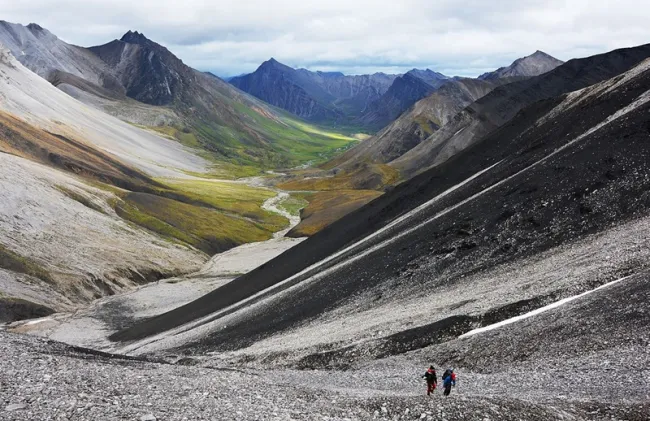
Gates of the Arctic National Park and Preserve is one of the most remote and untouched wilderness areas in the United States. Located in northern Alaska, this park is entirely above the Arctic Circle, offering a unique experience of the Arctic's vast, pristine landscape. Covering over 8.4 million acres, it is the second-largest national park in the U.S. and is known for its rugged beauty, solitude, and the opportunity for true wilderness adventures. With no roads, trails, or established campsites, the park is ideal for those seeking a raw and immersive experience in nature.
History of the Park
Gates of the Arctic was designated a national park in 1980 under the Alaska National Interest Lands Conservation Act. However, the area's significance was recognized much earlier. Renowned naturalist and explorer Bob Marshall coined the name "Gates of the Arctic" in 1929, inspired by two tall peaks that flank the North Fork of the Koyukuk River, which he described as the "Gates." The park is home to the Inupiat and Athabascan people, who have lived in the region for thousands of years. Their cultural legacy continues to influence the area today, and visitors can learn about their traditional ways of life through interpretive programs.
Main Features
Gates of the Arctic is characterized by its vast, untamed wilderness. The park encompasses six wild rivers, including the Noatak and Alatna Rivers, as well as the Brooks Range, which forms a dramatic backdrop to the park's landscape. Wildlife is abundant, with caribou, grizzly bears, wolves, and Dall sheep roaming the area. The park is also a haven for birdwatchers, with species like the golden eagle and the Arctic tern frequently spotted.
The park's isolation means that visitors must be entirely self-sufficient, carrying all the gear and supplies necessary for their trip. The beauty of the park lies in its untouched nature, where visitors can experience the Arctic tundra, glaciers, and mountain peaks in their most natural state.
Types of Trails
Gates of the Arctic is unique in that it has no established trails. Hiking here requires navigation skills and a willingness to forge your own path through the wilderness. Most visitors explore the park via river routes, using packrafts or canoes to travel along the major rivers. Backpacking is also a popular activity, with many hikers choosing to traverse the tundra or climb the park's peaks. The lack of trails means that every visit to Gates of the Arctic is a unique adventure.
Crowd Expectations
Gates of the Arctic is one of the least visited national parks in the U.S., with fewer than 10,000 visitors annually. The remote location and lack of amenities contribute to the low visitor numbers, making it an ideal destination for those seeking solitude. Visitors can expect to have vast expanses of the park entirely to themselves, with only the sounds of nature accompanying their journey.
Accessibility for Seniors and Wheelchairs
Due to its remote and rugged nature, Gates of the Arctic offers very limited accessibility for seniors and people with disabilities. There are no roads or developed infrastructure within the park, which makes it challenging for those with mobility issues. The closest towns, such as Bettles and Anaktuvuk Pass, offer limited services, but access to the park requires bush planes, and exploring the wilderness requires a high level of physical fitness and outdoor skills.
Park Amenities
As a wilderness park, Gates of the Arctic has no visitor centers, roads, or services within its boundaries. The nearby town of Bettles serves as the main gateway to the park, with a ranger station where visitors can obtain information and permits. There are no restaurants, stores, or other amenities within the park, so visitors must come fully prepared with all necessary supplies.
Camping Facilities
Camping in Gates of the Arctic is a true backcountry experience. There are no designated campsites, and visitors are free to set up camp wherever they choose. The park follows a leave-no-trace policy, so campers must pack out all waste and be mindful of their impact on the environment. Visitors should be prepared for challenging weather conditions, as the Arctic climate can be unpredictable, even in the summer months.
Access to Lodging
There are no lodges or hotels within Gates of the Arctic National Park itself. The nearest lodging options are in the surrounding communities, such as Bettles, where visitors can find a small lodge and guest services. For those seeking a more immersive experience, guided trips with local outfitters often include accommodations in remote campsites or wilderness lodges outside the park's boundaries.
Pet-Friendliness
Pets are allowed in Gates of the Arctic National Park, but owners should be aware of the challenges that come with bringing a pet into such a remote and wild environment. Pets must be kept on a leash or under strict control at all times to protect wildlife and the delicate ecosystem. Owners should be prepared to manage their pet's waste and ensure that their animals are well-suited for the rugged conditions of the Arctic wilderness.
Best Months to Visit
The best time to visit Gates of the Arctic is during the summer months, from late June to early September. During this time, the weather is milder, with temperatures ranging from 50°F to 70°F, and the sun remains above the horizon for nearly 24 hours, offering endless daylight for exploration. The winter months are extremely harsh, with temperatures plunging well below freezing, limited daylight, and challenging travel conditions.
Conclusion
Gates of the Arctic National Park is a destination for true adventurers. Its remoteness, lack of infrastructure, and pristine wilderness offer a unique opportunity to experience the Arctic as it has existed for millennia. Visitors should come prepared for an entirely self-sufficient journey into one of the last truly wild places on Earth. Whether traveling by river, hiking across the tundra, or simply soaking in the vast solitude, Gates of the Arctic provides an unparalleled connection to nature.



